Candida intermedia CBS 141442: A Novel Glucose/Xylose Co-Fermenting Isolate for Lignocellulosic Bioethanol Production
Abstract
1. Introduction
2. Materials and Methods
2.1. Microorganisms and Media Composition
2.2. Fermentation of the Lignocellulosic Hydrolysate
2.3. Batch and Fed-Batch Fermentation in Synthetic Medium
- (a)
- Batch SHF: initial addition of 10 g/L glucose and 20 g/L xylose with no additional feeding (Figure 1a).
- (b)
- SHF + fed-batch SSF: initial addition of 10 g/L glucose and 20 g/L xylose and supply of additional glucose and xylose (to avoid the dilution of xylose as the volume increased) during the fermentation process by the addition of 20 mL synthetic medium containing 200 g/L glucose and 20 g/L xylose at 12 h, 24 h and 36 h (Figure 1b).
- (c)
- SSF: initial addition of 10 g/L glucose and 20 g/L xylose and additional supply of glucose and xylose (to avoid the dilution of xylose as the volume increased) during the fermentation process by the continuous feeding of synthetic medium containing 200 g/L glucose and 20 g/L xylose from 12 to 60 h of fermentation at a flow rate of 3 mL/h (Figure 1c).
2.4. Analytical Methods
3. Results
3.1. Isolation of C. intermedia Clone I5
3.2. Characterization of C. intermedia Isolates
3.3. Fermentation Performance of C. intermedia CBS 141,442 in Wheat Straw Hydrolysate
3.4. Fermentation Performance of C. intermedia CBS 141442 under Different Fermentation Strategies
4. Discussion
Author Contributions
Funding
Acknowledgments
Conflicts of Interest
References
- Kummamuru, B. Global Bioenergy Statistics; World Bioenergy Association: Stockholm, Sweden, 2019; Available online: https://worldbioenergy.org/uploads/191129%20WBA%20GBS%202019_HQ.pdf (accessed on 1 September 2020).
- McKendry, P. Energy production from biomass (part 1): Overview of biomass. Bioresour. Technol. 2002, 83, 37–46. [Google Scholar] [CrossRef]
- Moreno, A.D.; Olsson, L. Pretreatment of lignocellulosic feedstocks. In Extremophilic Enzymatic Processing of Lignocellulosic Feedstocks to Bioenergy; Sani, R.K., Krishnaraj, R.N., Eds.; Springer International Publishing AG: Cham, Switzerland, 2017; pp. 31–52. [Google Scholar]
- Moreno, A.D.; Tomás-Pejó, E.; Ballesteros, M.; Negro, M.J. Pretreatment technologies for lignocellulosic biomass deconstruction within a biorefinery perspective. In Biofuels: Alternative Feedstocks and Conversion Processes for the Production of Liquid and Gaseous Biofuels, 2nd ed.; Pandey, A., Larroche, C., Dussap, C.-G., Gnansounou, E., Khanal, S.K., Ricke, S., Eds.; Academic Press: Cambridge, MA, USA, 2019; pp. 379–399. [Google Scholar]
- Alfani, F.; Gallifuoco, A.; Saporosi, A.; Spera, A.; Cantarella, M. Comparison of SHF and SSF processes for the bioconversion of steam-exploded wheat straw. J. Ind. Microbiol. Biotechnol. 2000, 25, 184–192. [Google Scholar] [CrossRef]
- Tomás-Pejó, E.; Oliva, J.M.; Ballesteros, M.; Olsson, L. Comparison of SHF and SSF processes from steam-exploded wheat straw for ethanol production by xylose-fermenting and robust glucose-fermenting Saccharomyces cerevisiae strains. Biotechnol. Bioeng. 2008, 100, 1122–1131. [Google Scholar] [CrossRef] [PubMed]
- Hou, J.; Qiu, C.; Shen, Y.; Li, H.; Bao, X. Engineering of Saccharomyces cerevisiae for the efficient co-utilization of glucose and xylose. FEMS Yeast Res. 2017, 17. [Google Scholar] [CrossRef] [PubMed]
- Gancedo, J.M. Yeast carbon catabolite repression. Microbiol. Mol. Biol. Rev. 1998, 62, 334–361. [Google Scholar] [CrossRef]
- Moyses, D.N.; Reis, V.C.; de Almeida, J.R.; de Moraes, L.M.; Torres, F.A. Xylose fermentation by Saccharomyces cerevisiae: Challenges and prospects. Int. J. Mol. Sci. 2016, 17, 207. [Google Scholar] [CrossRef]
- Moreno, A.D.; Carbone, A.; Pavone, R.; Olsson, L.; Geijer, C. Evolutionary engineered Candida intermedia exhibits improved xylose utilization and robustness to lignocellulose-derived inhibitors and ethanol. Appl. Microbiol. Biotechnol. 2019, 103, 1405–1416. [Google Scholar] [CrossRef]
- Gárdonyi, M.; Österberg, M.; Rodrigues, C.; Spencer-Martins, I.; Hahn-Hägerdal, B. High capacity xylose transport in Candida intermedia PYCC 4715. FEMS Yeast Res. 2003, 3, 45–52. [Google Scholar]
- Leandro, M.J.; Goncalves, P.; Spencer-Martins, I. Two glucose/xylose transporter genes from the yeast Candida intermedia: First molecular characterization of a yeast xylose-H+ symporter. Biochem. J. 2006, 395, 543–549. [Google Scholar] [CrossRef]
- Geijer, C.; Faria-Oliveira, F.; Moreno, A.D.; Stenberg, S.; Mazurkewich, S.; Olsson, L. Genomic and transcriptomic analysis of Candida intermedia reveals the genetic determinants for its xylose-converting capacity. Biotechnol. Biofuels 2020, 13, 48. [Google Scholar] [CrossRef]
- Kurtzman, C.P.; Robnett, C.J. Identification of clinically important ascomycetous yeasts based on nucleotide divergence in the 5’ end of the large-subunit (26S) ribosomal DNA gene. J. Clin. Microbiol. 1997, 35, 1216–1223. [Google Scholar] [CrossRef] [PubMed]
- Kurtzman, C.P.; Robnett, C.J. Identification and phylogeny of ascomycetous yeasts from analysis of nuclear large subunit (26S) ribosomal DNA partial sequences. Antonie Van Leeuwenhoek 1998, 73, 331–371. [Google Scholar] [CrossRef] [PubMed]
- Negro, M.J.; Álvarez, C.; Ballesteros, I.; Romero, I.; Ballesteros, M.; Castro, E.; Manzanares, P.; Moya, M.; Oliva, J.M. Ethanol production from glucose and xylose obtained from steam exploded water-extracted olive tree pruning using phosphoric acid as catalyst. Bioresour. Technol. 2014, 153, 101–107. [Google Scholar] [CrossRef]
- Verduyn, C.; Postma, E.; Scheffers, W.A.; van Dijken, J.P. Physiology of Saccharomyces cerevisiae in anaerobic glucose-limited chemostat cultures. J. Gen. Microbiol. 1990, 136, 395–403. [Google Scholar] [CrossRef]
- Nielsen, F.; Zacchi, G.; Galbe, M.; Wallberg, O. Prefermentation improves ethanol yield in separate hydrolysis and cofermentation of steam-pretreated wheat straw. Sustain. Chem. Process. 2016, 4, 10. [Google Scholar] [CrossRef]
- Nielsen, F.; Tomás-Pejó, E.; Olsson, L.; Wallberg, O. Short-term adaptation during propagation improves the performance of xylose-fermenting Saccharomyces cerevisiae in simultaneous saccharification and co-fermentation. Biotechnol. Biofuels 2015, 8, 219. [Google Scholar] [CrossRef] [PubMed]
- Su, Y.K.; Willis, L.B.; Jeffries, T.W. Effects of aeration on growth, ethanol and polyol accumulation by Spathaspora passalidarum NRRL Y-27907 and Scheffersomyces stipitis NRRL Y-7124. Biotechnol. Bioeng. 2015, 112, 457–469. [Google Scholar] [CrossRef] [PubMed]
- Skoog, K.; Hahn-Hägerdal, B. Effect of oxygenation on xylose fermentation by Pichia stipitis. Appl. Environ. Microbiol. 1990, 56, 3389–3394. [Google Scholar] [CrossRef]
- Cannella, D.; Jørgensen, H. Do new cellulolytic enzyme preparations affect the industrial strategies for high solids lignocellulosic ethanol production? Biotechnol. Bioeng. 2014, 111, 59–68. [Google Scholar] [CrossRef]
- Van Vleet, J.H.; Jeffries, T.W. Yeast metabolic engineering for hemicellulosic ethanol production. Curr. Opin. Biotechnol. 2009, 20, 300–306. [Google Scholar] [CrossRef]
- Nakanishi, S.C.; Soares, L.B.; Biazi, L.E.; Nascimento, V.M.; Costa, A.C.; Rocha, G.J.M.; Ienczak, J.L. Fermentation strategy for second generation ethanol production from sugarcane bagasse hydrolyzate by Spathaspora passalidarum and Scheffersomyces stipitis. Biotechnol. Bioeng. 2017, 114, 2211–2221. [Google Scholar] [CrossRef] [PubMed]
- Slininger, P.J.; Shea-Andersh, M.A.; Thompson, S.R.; Dien, B.S.; Kurtzman, C.P.; Balan, V.; da Costa Sousa, L.; Uppugundla, N.; Dale, B.E.; Cotta, M.A. Evolved strains of Scheffersomyces stipitis achieving high ethanol productivity on acid- and base-pretreated biomass hydrolyzate at high solids loading. Biotechnol. Biofuels 2015, 8, 60. [Google Scholar] [CrossRef] [PubMed]
- Saito, M.; Nagasaki, H.; Watanabe, S.; Fujimoto, T. Ethanol production from sugars in hydrolysates of cellulosic biomass resources with xylose-fermenting yeast Candida intermedia 4-6-4T2. J. Jpn. Pet. Inst. 2017, 60, 127–136. [Google Scholar] [CrossRef]
- Lee, Y.G.; Jin, Y.S.; Cha, Y.L.; Seo, J.H. Bioethanol production from cellulosic hydrolysates by engineered industrial Saccharomyces cerevisiae. Bioresour. Technol. 2017, 228, 355–361. [Google Scholar] [CrossRef]
- Song, Q.; Kumar, A. An overview of autophagy and yeast pseudohyphal growth: Integration of signaling pathways during nitrogen stress. Cells 2012, 1, 263–283. [Google Scholar] [CrossRef]
- Lu, Y.; Su, C.; Solis, N.V.; Filler, S.G.; Liu, H. Synergistic regulation of hyphal elongation by hypoxia, CO2, and nutrient conditions controls the virulence of Candida albicans. Cell Host Microbe 2013, 14, 499–509. [Google Scholar] [CrossRef]
- Desai, P.R.; van Wijlick, L.; Kurtz, D.; Juchimiuk, M.; Ernst, J.F. Hypoxia and temperature regulated morphogenesis in Candida albicans. PLoS Genet. 2015, 11, e1005447. [Google Scholar] [CrossRef]
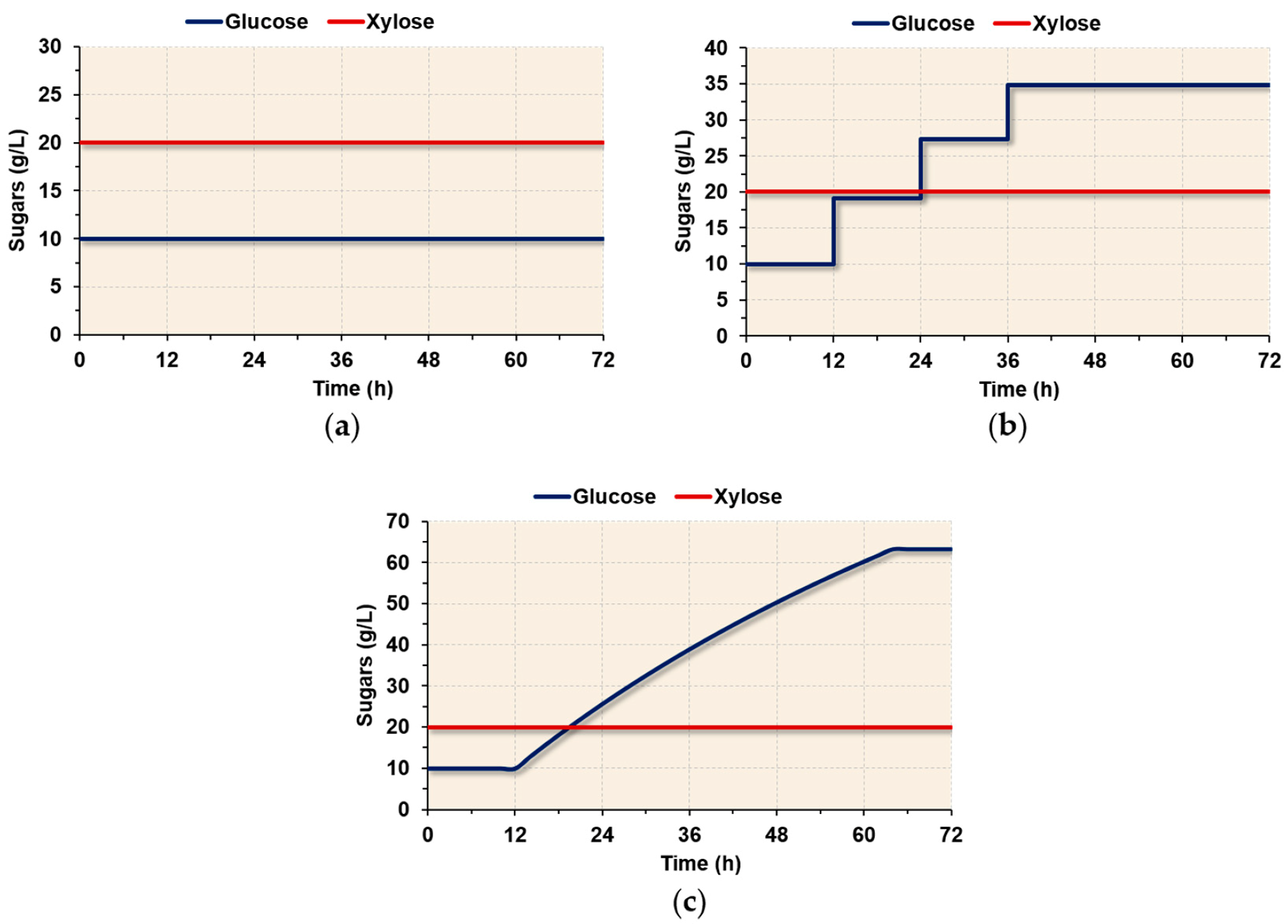

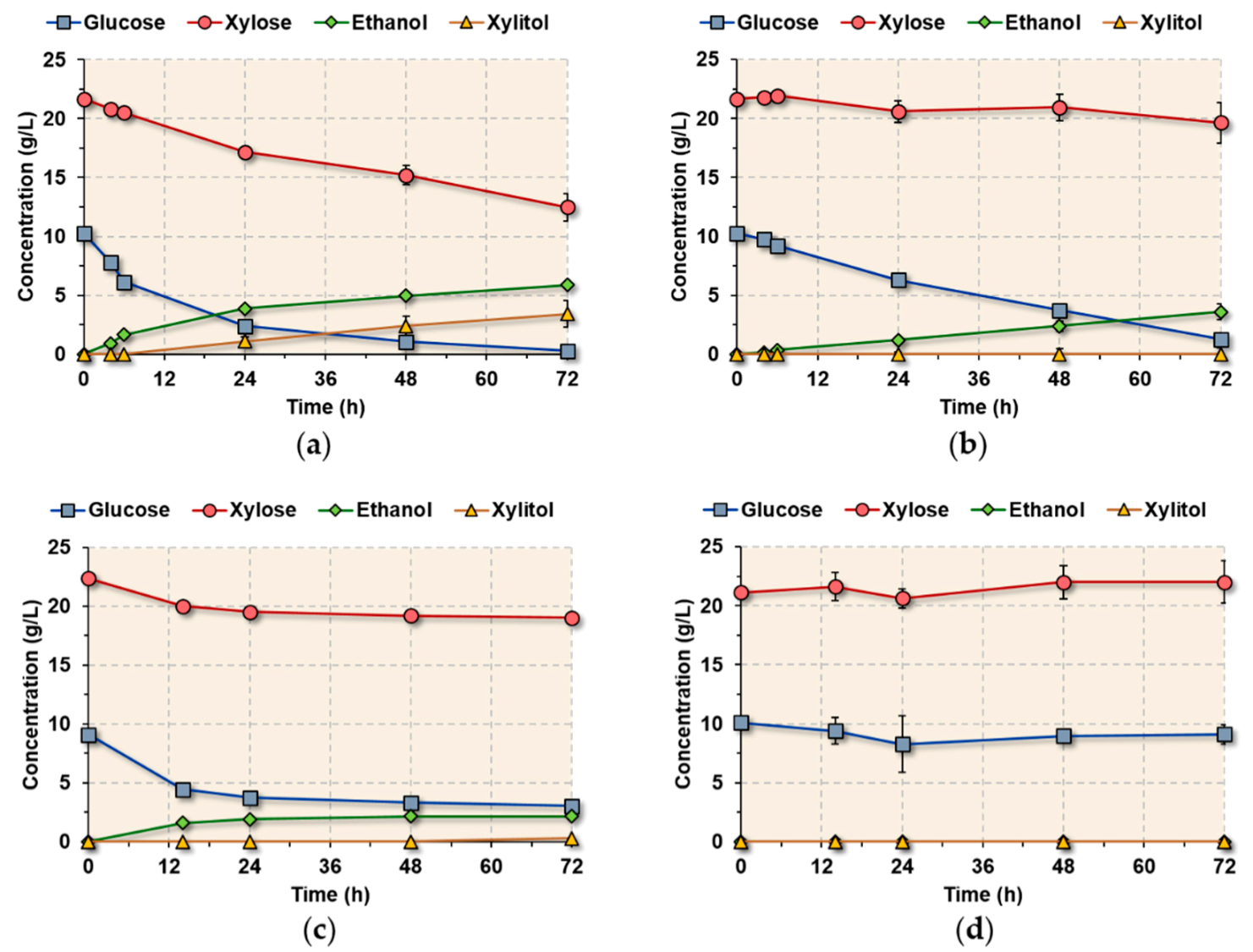
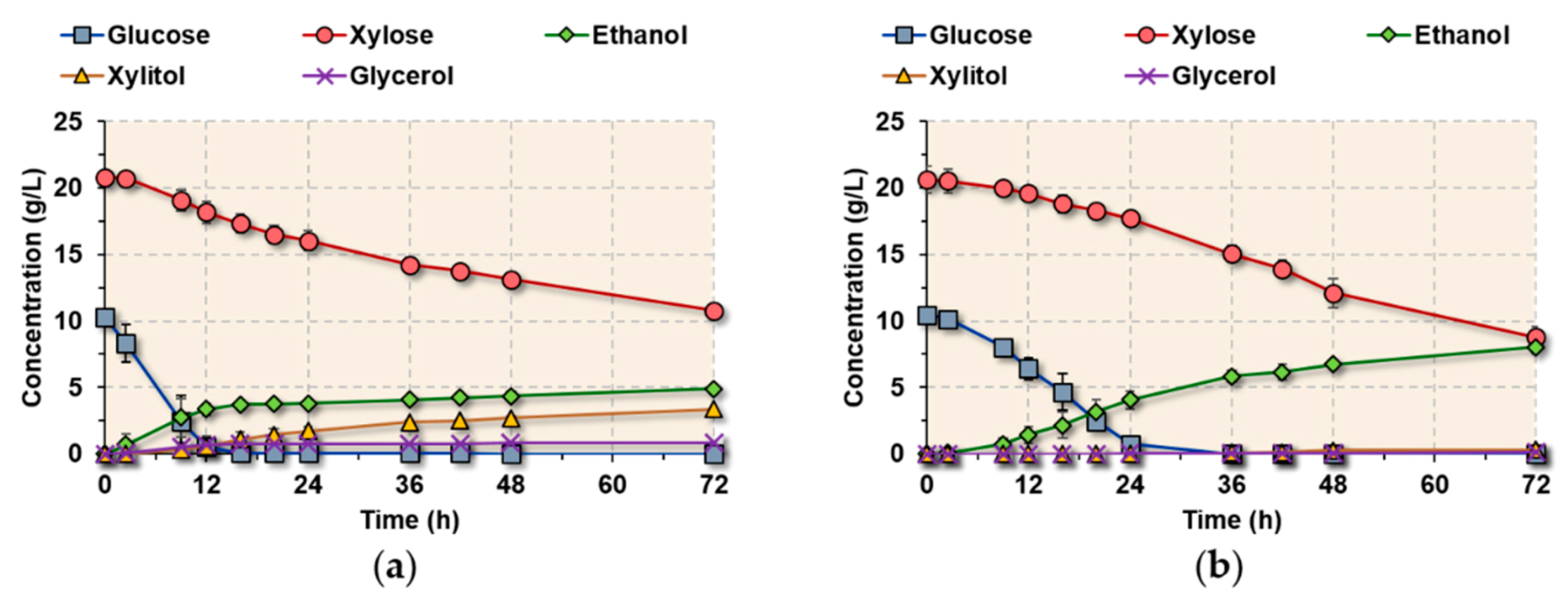
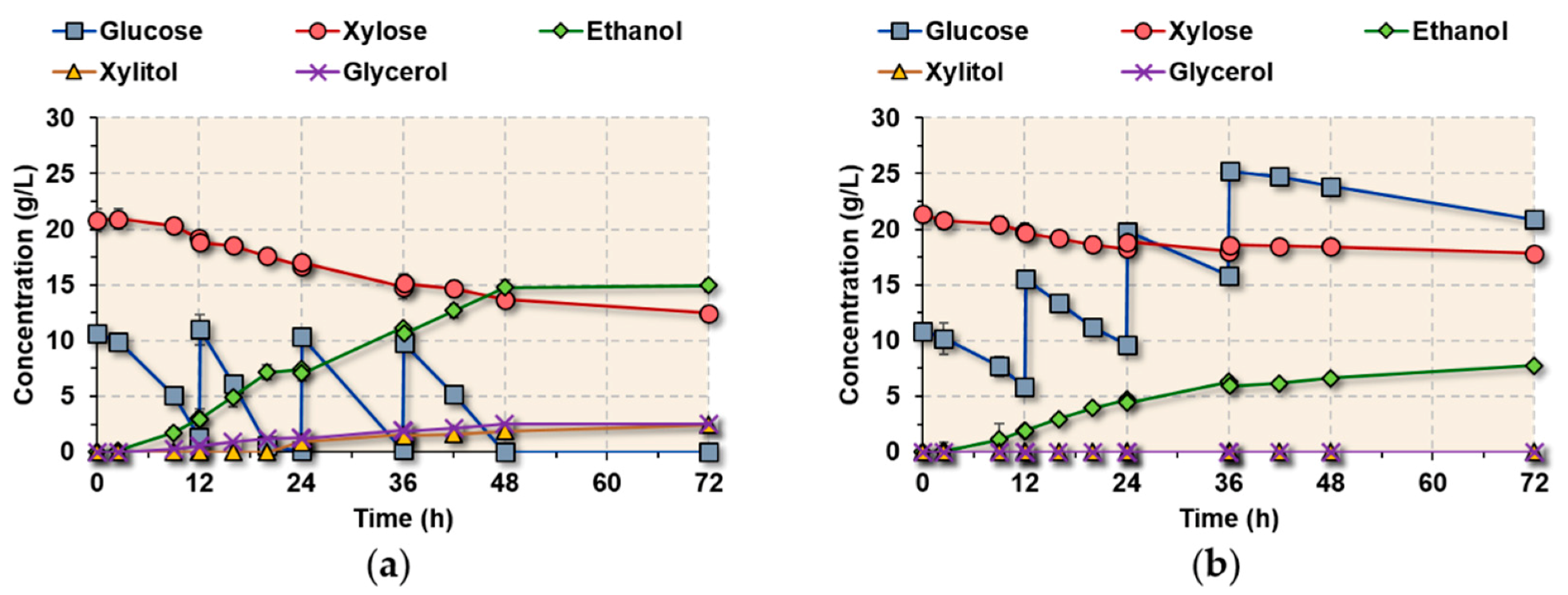
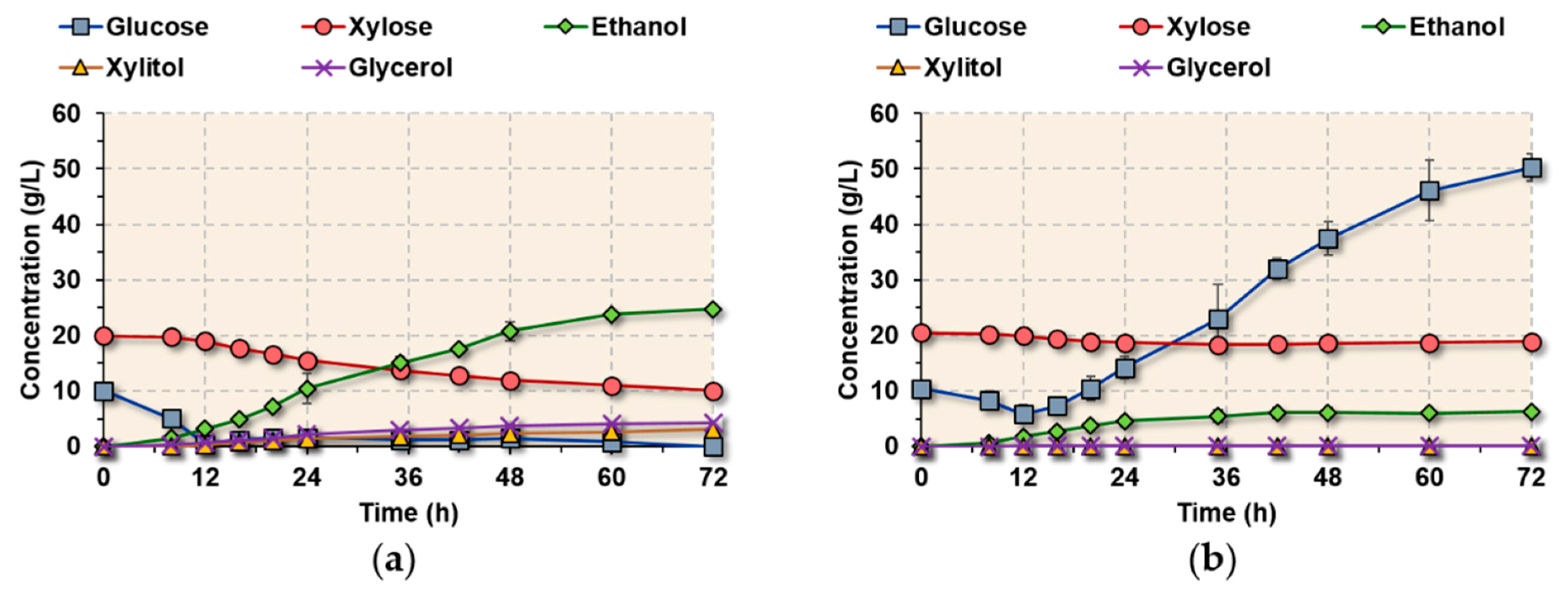
| Colony Morphology | Clone | Ethanol Yield (g/g) a | Xylose Consumed (%) | Xylitol Yield (g/g) b |
|---|---|---|---|---|
| Smooth | S1 | 0.24 ± 0.04 | 47.2 ± 20.7 | 0.15 ± 0.06 |
| S2 | 0.23 ± 0.02 | 58.8 ± 8.9 | 0.21 ± 0.06 | |
| S3 | 0.22 ± 0.00 | 59.4 ± 5.9 | 0.18 ± 0.01 | |
| S4 | 0.22 ± 0.01 | 64.9 ± 10.8 | 0.20 ± 0.01 | |
| S5 | 0.17 ± 0.00 | 67.0 ± 0.6 | 0.22 ± 0.00 | |
| Intermediate | I1 | 0.16 ± 0.01 | 80.5 ± 10.3 | 0.15 ± 0.10 |
| I2 | 0.21 ± 0.03 | 49.3 ± 21.0 | 0.29 ± 0.02 | |
| I3 | 0.23 ± 0.01 | 71.5 ± 23.5 | 0.27 ± 0.08 | |
| I4 | 0.22 ± 0.00 | 95.1 ± 5.4 | 0.14 ± 0.02 | |
| I5 | 0.25 ± 0.02 | 91.1 ± 6.0 | 0.13 ± 0.10 | |
| I6 | 0.19 ± 0.00 | 67.4 ± 6.2 | 0.29 ± 0.02 | |
| I7 | 0.23 ± 0.00 | 80.4 ± 10.6 | 0.16 ± 0.07 | |
| Complex | C1 | 0.22 ± 0.09 | 82.1 ± 21.3 | 0.03 ± 0.04 |
| C2 | 0.28 ± 0.00 | 68.4 ± 15.3 | 0.04 ± 0.06 | |
| C3 | 0.30 ± 0.01 | 63.4 ± 0.8 | 0.07 ± 0.01 | |
| C4 | 0.28 ± 0.03 | 80.6 ± 23.5 | 0.00 ± 0.00 | |
| C5 | 0.29 ± 0.01 | 65.9 ± 4.7 | 0.09 ± 0.04 | |
| C6 | 0.26 ± 0.01 | 73.6 ± 10.0 | 0.15 ± 0.07 |
| Fermenting Conditions | Microorganism | Ethanol Yield (g/g) † | Xylose Consumed (%) | Xylitol Yield (g/g) ‡ |
|---|---|---|---|---|
| 40% (v/v) hydrolysate | C. intermedia CBS 141442 | 0.30 ± 0.01 a | 42.4 ± 6.4 a,b | 0.37 ± 0.04 a |
| Batch SHF | 0.24 ± 0.00 b | 48.1 ± 1.8 b | 0.33 ± 0.01 a | |
| SHF + fed-batch SSF | 0.31 ± 0.00 a | 44.3 ± 4.7 b | 0.25 ± 0.01 b | |
| SSF | 0.34 ± 0.01 a,c | 49.7 ± 3.2 b | 0.31 ± 0.02 a,b | |
| 40% (v/v) hydrolysate | S. stipitis CBS 6054 | 0.33 ± 0.02 a,c | 9.4 ± 8.6 c | 0.00 ± 0.01 c |
| Batch SHF | 0.36 ± 0.00 c,d | 57.5 ± 4.1 b | 0.03 ± 0.01 c | |
| SHF + fed-batch SSF | 0.33 ± 0.00 a,c | 21.6 ± 3.5 a,c | 0.00 ± 0.00 c | |
| SSF | 0.40 ± 0.01 d | 6.5 ± 2.9 c | 0.00 ± 0.00 c |
Publisher’s Note: MDPI stays neutral with regard to jurisdictional claims in published maps and institutional affiliations. |
© 2020 by the authors. Licensee MDPI, Basel, Switzerland. This article is an open access article distributed under the terms and conditions of the Creative Commons Attribution (CC BY) license (http://creativecommons.org/licenses/by/4.0/).
Share and Cite
Moreno, A.D.; Tomás-Pejó, E.; Olsson, L.; Geijer, C. Candida intermedia CBS 141442: A Novel Glucose/Xylose Co-Fermenting Isolate for Lignocellulosic Bioethanol Production. Energies 2020, 13, 5363. https://doi.org/10.3390/en13205363
Moreno AD, Tomás-Pejó E, Olsson L, Geijer C. Candida intermedia CBS 141442: A Novel Glucose/Xylose Co-Fermenting Isolate for Lignocellulosic Bioethanol Production. Energies. 2020; 13(20):5363. https://doi.org/10.3390/en13205363
Chicago/Turabian StyleMoreno, Antonio D., Elia Tomás-Pejó, Lisbeth Olsson, and Cecilia Geijer. 2020. "Candida intermedia CBS 141442: A Novel Glucose/Xylose Co-Fermenting Isolate for Lignocellulosic Bioethanol Production" Energies 13, no. 20: 5363. https://doi.org/10.3390/en13205363
APA StyleMoreno, A. D., Tomás-Pejó, E., Olsson, L., & Geijer, C. (2020). Candida intermedia CBS 141442: A Novel Glucose/Xylose Co-Fermenting Isolate for Lignocellulosic Bioethanol Production. Energies, 13(20), 5363. https://doi.org/10.3390/en13205363






